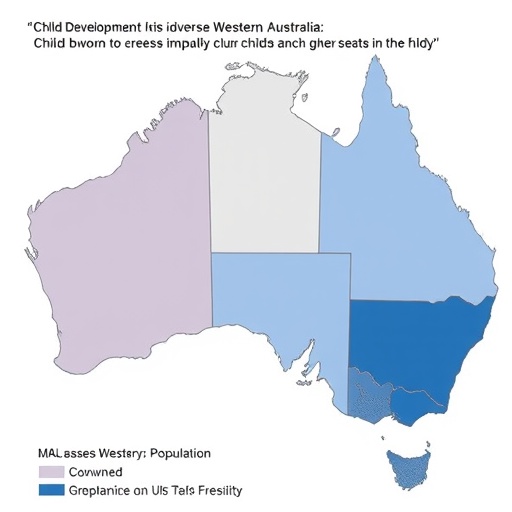
In a groundbreaking population-based study published in the World Journal of Pediatrics, researchers have shed new light on the developmental vulnerabilities experienced by children from culturally and linguistically diverse (CALD) backgrounds in Western Australia. This extensive investigation, led by Atalell, K.A., Pereira, G., Duko, B., and their colleagues, marks a pivotal step in understanding how multicultural factors influence child development in one of the most diverse regions of Australia. The study’s implications resonate broadly with policymakers, educators, and healthcare providers aiming to bridge disparities in child development outcomes.
Developmental vulnerability in early childhood is a critical public health concern that encapsulates a child’s ability to cope with milestones across various domains such as social skills, emotional regulation, cognitive ability, language acquisition, and physical health. Particularly for children from CALD backgrounds, these development indices can inform targeted interventions to support healthy growth trajectories. The research team embarked on an ambitious project to systematically quantify and characterize the developmental challenges faced by these children, deploying rigorous epidemiological methods across a comprehensive dataset that represents a diverse population base.
The authors tapped into administrative and health data repositories spanning several years to extract patterns linked with culture, language spoken at home, and socio-economic status—variables often intertwined yet rarely studied in concert. Their analysis accounted for confounding factors such as parental education, income levels, and access to early childhood education and healthcare services. This multi-layered approach enabled them to isolate specific risk factors and protective elements unique to CALD children, offering a holistic picture of the developmental landscape they navigate.
.adsslot_rzF6kLYbx7{width:728px !important;height:90px !important;}
@media(max-width:1199px){ .adsslot_rzF6kLYbx7{width:468px !important;height:60px !important;}
}
@media(max-width:767px){ .adsslot_rzF6kLYbx7{width:320px !important;height:50px !important;}
}
ADVERTISEMENT
One of the study’s striking findings is the elevated prevalence of developmental vulnerability among CALD children compared to their non-CALD peers. This disparity remains significant even after adjusting for socio-economic disadvantages, suggesting that language barriers and cultural dissonance exert an independent effect on child development. The research underscores that early childhood is a particularly sensitive period; delays or vulnerabilities at this stage can cascade into long-term educational and social challenges, perpetuating cycles of disadvantage.
From a methodological standpoint, the study employed validated developmental assessment tools, integrating quantitative scoring with qualitative contextual data. These instruments measured outcomes across five critical domains—physical health and well-being, social competence, emotional maturity, language and cognitive skills, and communication skills. The inclusion of both standardized test metrics and culturally responsive evaluations highlights the research team’s commitment to methodological rigor and cultural sensitivity.
Moreover, the authors addressed the heterogeneity within CALD populations, recognizing that these groups are not monolithic. Subgroups defined by differing linguistic backgrounds, migration histories, and community integration levels displayed varying degrees of developmental outcomes. For instance, children from recently arrived refugee families exhibited more pronounced vulnerabilities than those from longer-established communities, signaling the complex interplay of trauma, access to services, and social support networks.
This article also explores the role of parental engagement and community resources in modulating developmental trajectories. Parents’ proficiency in the dominant language, their familiarity with local education systems, and their socioeconomic stability emerged as critical determinants influencing child development. The findings advocate for culturally tailored support programs that not only address language acquisition but also enhance parental empowerment and community connectedness.
Importantly, the study critiques existing early childhood initiatives and calls for a recalibration of service delivery models to better accommodate linguistic and cultural diversity. The conventional one-size-fits-all frameworks may inadvertently marginalize CALD children, reinforcing developmental gaps. Instead, integrating interpreters, multicultural liaison officers, and culturally attuned educators within early development programs is paramount for fostering equitable outcomes.
The research also offers a novel perspective on the neurodevelopmental implications of sustained cultural displacement and linguistic transition. It provocatively suggests that bilingualism and multilingualism, while often advantageous cognitively, may initially introduce challenges in standardized developmental assessments that do not account for language context. This raises important questions about the validity and cultural fairness of existing developmental screening tools.
Beyond immediate developmental impacts, the study projects long-term societal consequences if these vulnerabilities remain unaddressed. Given that early childhood developmental deficits are linked to diminished academic achievement, reduced workforce participation, and increased health burdens, the economic and social costs to communities are substantial. The research team calls for urgent policy responses that integrate early childhood development strategies within broader multicultural inclusion policies.
The authors emphasize the necessity for future longitudinal research to trace the developmental trajectories of CALD children over time, examining how early vulnerabilities interact with schooling quality, peer relationships, and family dynamics. Such data can illuminate pathways of resilience and risk, guiding nuanced intervention design tailored to specific cultural contexts.
This comprehensive study not only enriches scientific understanding but also imparts a resounding message: cultural and linguistic diversity must be foremost considerations in pediatric developmental health strategies. The Western Australian case study serves as a microcosm of global trends in migration and cultural plurality, making these findings globally relevant amid increasing international mobility and diversity.
In essence, the article frames developmental vulnerability as a complex, multifactorial phenomenon intricately linked with socio-cultural determinants. Addressing these challenges demands an interdisciplinary approach uniting healthcare, education, social services, and community organizations to foster environments where CALD children can thrive.
Finally, this research sets a precedent for employing population-level data in conjunction with culturally nuanced analysis to unmask hidden vulnerabilities in child development. By combining epidemiologic precision with cultural competence, the study charts a course toward more inclusive and effective early childhood development policies, ultimately supporting the well-being of future generations in diverse societies worldwide.
Subject of Research: Developmental vulnerability among children from culturally and linguistically diverse backgrounds in Western Australia.
Article Title: Developmental vulnerability in children from culturally and linguistically diverse backgrounds in Western Australia: a population-based study.
Article References:
Atalell, K.A., Pereira, G., Duko, B. et al. Developmental vulnerability in children from culturally and linguistically diverse backgrounds in Western Australia: a population-based study. World J Pediatr 21, 744–754 (2025). https://doi.org/10.1007/s12519-025-00936-0
Image Credits: AI Generated
DOI: July 2025
Tags: child development riskscognitive and emotional developmentculturally and linguistically diverse childrendevelopmental vulnerabilities in early childhoodearly childhood education disparitiesepidemiological study on child healthlanguage acquisition challengesmulticultural factors in child developmentpublic health concerns in child developmentsocio-economic impact on child developmenttargeted interventions for CALD childrenWestern Australia child health





